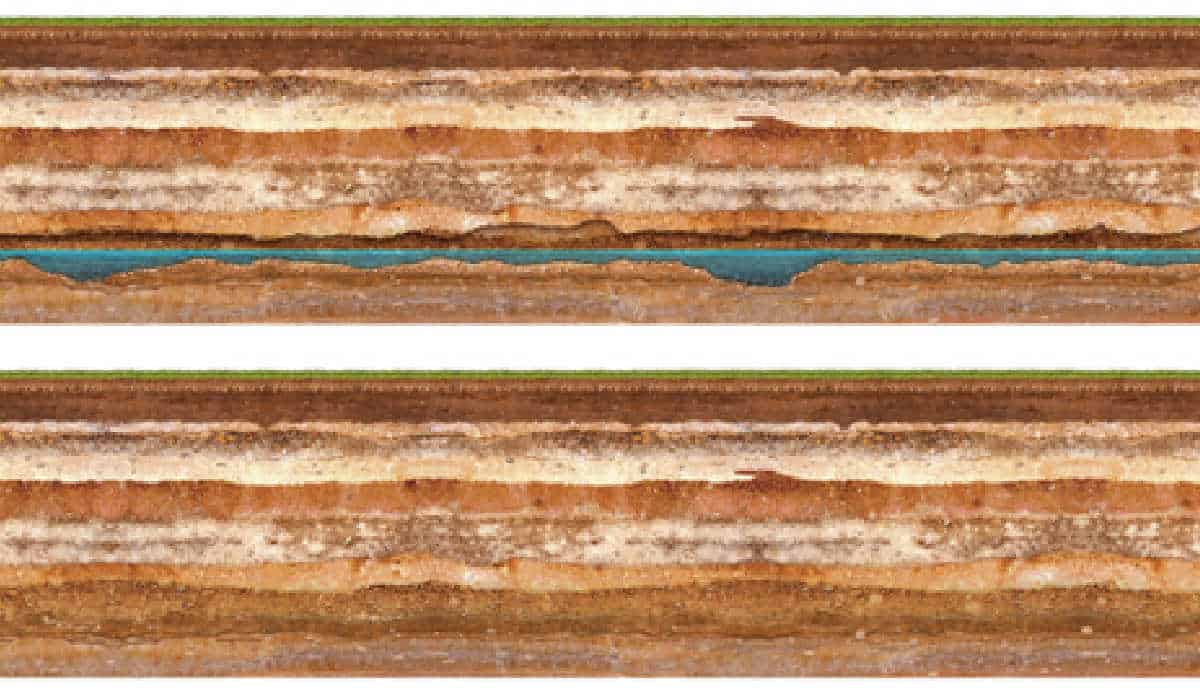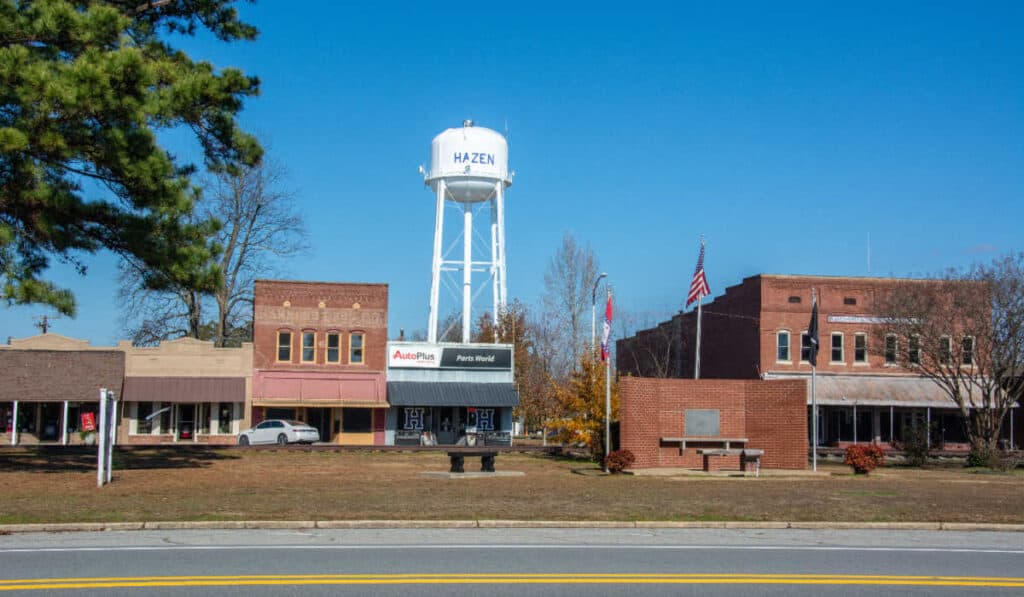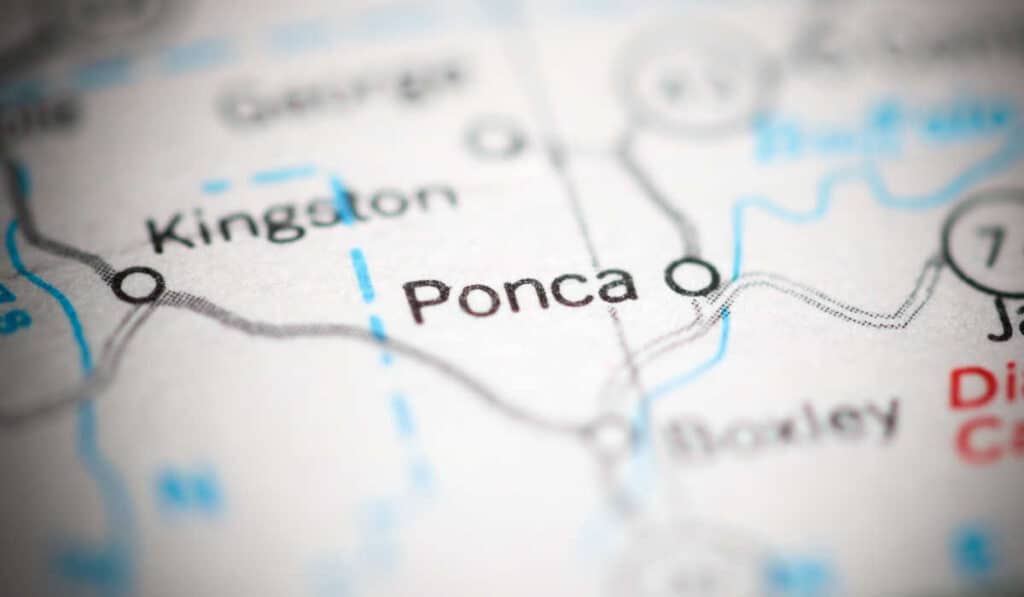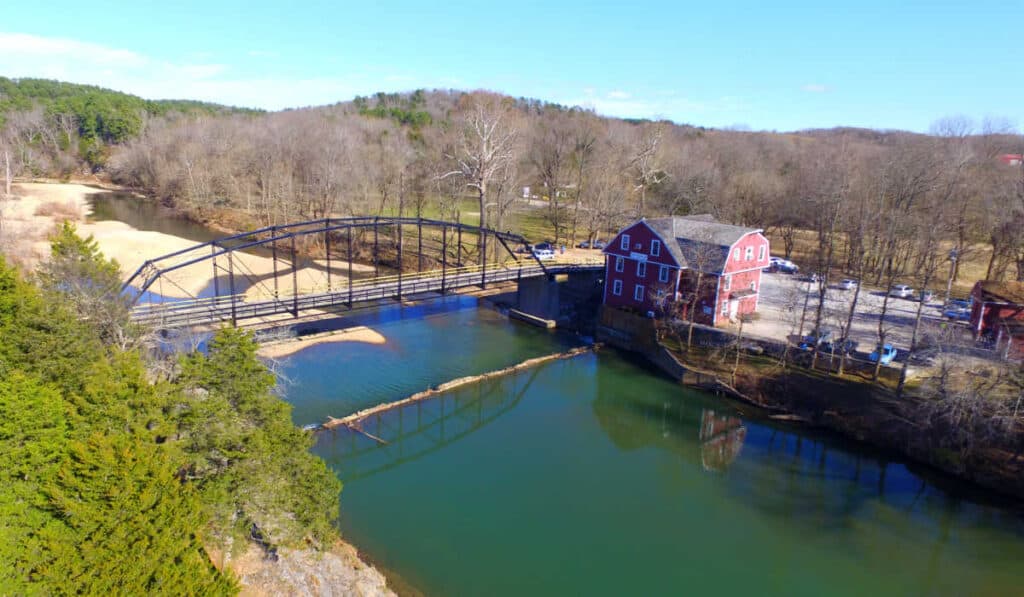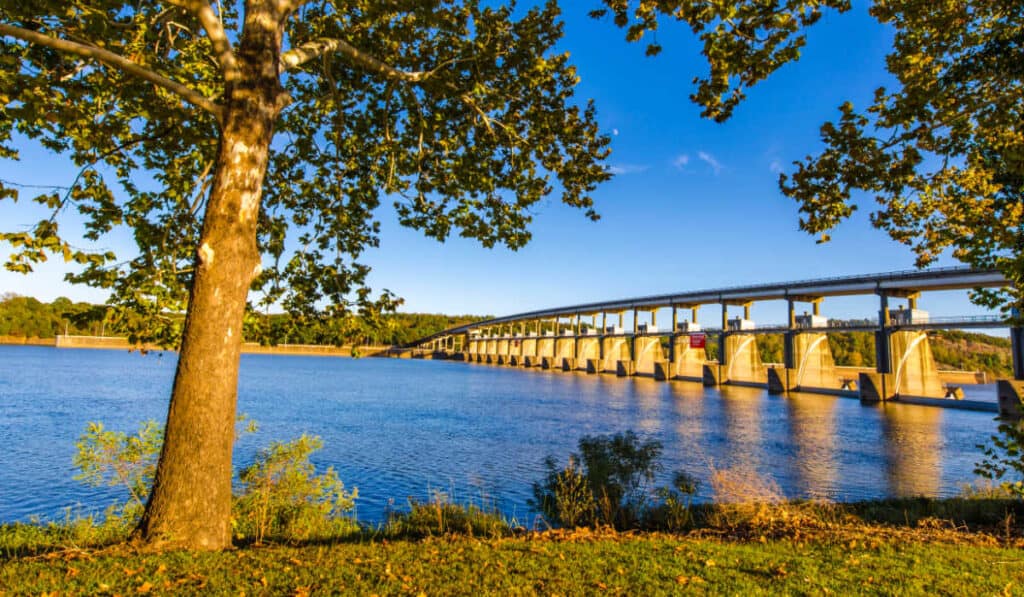The Ozark aquifer is a vital groundwater resource in the central United States, providing a crucial source of drinking water for the people living in the Ozark Plateaus region. Spanning several states, this extensive aquifer system is primarily comprised of dolomites and sandstones within the Roubidoux, Gasconade, Eminence, and Potosi Formations of Ordovician and Cambrian age. The thickness of the Ozark aquifer varies, ranging from 200 to 500 feet, making it an essential component of the area’s water supply infrastructure.
As a vital resource for public supply and domestic use in the region, understanding groundwater availability in the Ozark aquifer is vital for effectively managing and protecting this important ecosystem. The U.S. Geological Survey initiated a study in 2014 to evaluate fresh groundwater resources within the Ozark Plateaus as part of a broader national assessment of groundwater availability. This research helps inform decisions on how best to sustainably manage and preserve the precious water resources of the Ozark Plateaus aquifer system for future generations.
Furthermore, the Ozark aquifer serves as a valuable indicator for water quality in the region due to its widespread nature. By monitoring the quality of water in the aquifer system, it is possible to get a broader understanding of potential environmental issues such as contamination, overuse, or degradation of the aquatic ecosystems reliant upon the Ozark aquifer. As studies and assessments of groundwater availability continue, the knowledge and insights gained will be crucial for maintaining the sustainability of this critical water resource.
Overview of Ozark Aquifer
The Ozark Aquifer is a significant water-bearing unit that spans across areas of southern Missouri, northwestern and north-central Arkansas, southeastern Kansas, and northeastern Oklahoma. I’ve found that this aquifer plays a crucial role in the Ozark Plateaus Aquifer System, providing water resources for the region’s population and industries.
Comprising of dolomites and sandstones, the Ozark aquifer is found within the Roubidoux, Gasconade, Eminence, and Potosi Formations of Ordovician and Cambrian age. Ranging in thickness from 200 to 500 feet, it is an essential part of the region’s groundwater system.
Within the Ozark Plateaus aquifer system, the Ozark aquifer is the primary water-bearing unit. This aquifer system consists of three aquifers separated by two confining units, which grade laterally westward into equivalent hydrogeologic units that are part of the Western Interior Plains aquifer system.
The region is known for its karst landscapes, which significantly influence the character and behavior of the Ozark aquifer. Karst formations result from the dissolution of soluble rocks like limestone, dolomite, and gypsum, leading to the development of underground drainage systems, sinkholes, and caves. Due to the presence of these karst formations, the Ozark aquifer exhibits highly variable groundwater flow patterns and rapid recharge rates, factors that impact the availability and quality of water resources in the area.
In conclusion, the Ozark aquifer is a vital component of the larger Ozark Plateaus Aquifer System, providing water resources to a significant geographical area. With its distinct karst formations, this aquifer plays a critical role in supplying water to the region, while also posing unique challenges related to water availability and quality.
Geological Characteristics
The Ozark Plateaus aquifer system, a crucial groundwater resource in the central United States, is spread across various regions such as central, northeast, northwest, and west-central. I am quite familiar with the geological formations that make up this aquifer system, and would like to share some key features with you.
In the Ozark Plateaus, you will find several geologic formations that contribute to the groundwater availability. A significant part of this aquifer system consists of the Salem Plateau and Springfield Plateau. Both of these plateaus have their own distinctive characteristics.
The Salem Plateau, located in the northeast and west-central portions of the Ozark Plateaus, is dominated by dolomite and limestone. These rock formations contain numerous solution cavities and fractures which contribute to the high groundwater productivity. Dolomite is particularly porous, allowing water to flow through and recharge the aquifer efficiently.
In contrast, the Springfield Plateau, which is situated in the northwest portion of the Ozark Plateaus, is composed primarily of chert and limestone. Chert is a relatively impermeable rock, and thus contributes less to the overall groundwater storage and flow in this particular region. However, the limestone in this area still provides an important source of water to the aquifer system due to its greater permeability.
While speaking about the Ozark Plateaus aquifer system, I cannot ignore the important role played by karst features. Karst areas are characterized by distinctive landforms like springs, caves, and sinkholes, which result in aquifers that are highly productive but extremely vulnerable to contamination. The unique hydrogeology of these formations makes the management of groundwater resources in the Ozark Plateaus an intricate task.
To sum up, the Ozark Plateaus aquifer system is a complex network of geologic formations, composed mainly of dolomite, limestone, and chert, spread across various regions in the central United States. The Salem Plateau and Springfield Plateau contribute significantly to the groundwater availability, while various karst features create challenges in managing this essential resource.
Geographical Spread
The Ozark Plateaus aquifer system is a vast underground water source located in the central United States. This vital resource extends across several states, providing fresh drinking water and sustaining agriculture, industries, and natural ecosystems. I’d like to give you an overview of the geographical spread of this aquifer, which covers areas such as Missouri, Oklahoma, Kansas, and Arkansas.
In Missouri, the Ozark Plateaus aquifer system underlies most of the southern part of the state, being a significant water source for residents and businesses alike. Missouri is home to some of the main regions of the Ozark Plateaus physiographic province, including the Salem Plateau and the Springfield Plateau. These regions play a crucial role in the overall water flow and recharge of the aquifer system.
A relatively small part of the Ozark Plateaus aquifer system is found in southeastern Kansas, where it still serves as a reliable water source for the regional population and agricultural lands. Although not as extensive as in Missouri, this portion of the aquifer contributes to the interconnected network of underground water sources that form the Ozark Plateau.
In northwestern Arkansas, the Ozark Plateaus aquifer system covers a large area and is of particular importance for sustaining agriculture, fisheries, and the state’s growing population. Additionally, the region is home to the Boston Mountains, another essential part of the Ozark Plateau’s physiographic province that helps maintain the groundwater levels and overall availability.
Lastly, a small portion of the aquifer system is also present beneath northeastern Oklahoma, where it contributes to the local water supply and supports various economic activities. Although limited in extent compared to other states, this part of the Ozark Plateaus aquifer is key to the region’s overall water resources.
Role of USGS in Aquifer Studies
As someone who often studies the Ozark aquifer, I rely on the U.S. Geological Survey (USGS) for accurate and up-to-date information. The USGS plays a crucial role in conducting invaluable research on aquifers, helping us understand the delicate balance between abundance, sustainability, and scarcity of groundwater resources.
One aspect of the USGS’s aquifer research that has been particularly helpful for me is their extensive publications warehouse. The USGS Publications Warehouse is a treasure trove of information, providing access to over 170,000 publications authored by USGS scientists. With a user-friendly advanced search functionality, I can easily navigate through the vast array of resources and find exactly what I need for my studies.
There are several noteworthy studies on the Ozark aquifer available through the USGS, such as the Groundwater availability in the Ozark Plateaus aquifer system and The Ozark Plateaus Regional Aquifer Study—Documentation of a groundwater flow model. These publications have helped me gauge the historical effects of human activities on water levels, quantify groundwater resources under various conditions, and evaluate existing monitoring networks.
In addition, USGS’s commitment to providing open access to publications has made it even more convenient for researchers like myself. The new URL system they’ve implemented makes it simpler to share links and collaborate with fellow experts in the field.
Overall, the U.S. Geological Survey has proven to be an indispensable resource in my aquifer studies. Their extensive publications, knowledgeable scientists, and user-friendly website have significantly contributed to the advancement of research in this critical area of hydrogeology.
Water Resources and Usage
I would like to discuss the water resources and usage in the Ozark aquifer system. The Ozark Plateaus aquifer system consists of two aquifers, the Springfield Plateau aquifer and the Ozark aquifer, which play a crucial role in providing fresh water to the surrounding areas. These aquifers consist mainly of carbonate rocks that are Cambrian through Mississippian in age, providing a substantial and reliable source of groundwater ¹.
In the Ozark region, groundwater usage accounts for around 10% of the total water use, primarily for public supply and domestic groundwater withdrawals ². As of 2010, approximately 380 million gallons per day were pumped from the Ozark system aquifers, with the majority of the withdrawals coming from shallow alluvial aquifers ³.
The water levels in the Ozark aquifers get impacted due to human activities such as the drilling of wells. Increased human dependence on wells for water supply puts pressure on the aquifers and requires constant monitoring to maintain sustainable groundwater levels.
Irrigation is another factor that affects the water usage from the Ozark aquifer system. Even though groundwater only accounts for a small fraction of the total water use in the region, it’s essential for agriculture. Farmers rely on the aquifer system’s freshwater resources to irrigate their crops during periods of low rainfall.
Industrial and mining activities in the area also require water, and the Ozark aquifer system serves as a crucial source. Industries use this groundwater for cooling processes and other water-intensive applications. In mining, water is often utilized for drilling, mineral extraction, and processing. Conserving and managing the water resources from the Ozark aquifer system is vital to ensure the availability of freshwater for these sectors.
In summary, the Ozark Plateaus aquifer system plays a significant role in the provision of water resources for the surrounding regions. Groundwater is critical for public supply, domestic water needs, agriculture, industry, and mining. It’s essential to monitor the water levels in the aquifers and take steps to maintain their sustainability for future generations.
Publications and Resources
I came across some useful publications and resources for gaining a better understanding of the Ozark Plateaus aquifer system. One notable publication I found is the U.S. Geological Survey’s (USGS) Groundwater Availability in the Ozark Plateaus Aquifer System. This report provides valuable information on the use and management of groundwater in the aquifer system, including data on withdrawals for public supply, domestic, agriculture, livestock, and non-agricultural use like industrial and thermoelectric power generation.
Another important study is the Hydrogeology and Hydrologic Conditions of the Ozark Plateaus Aquifer System report. This publication discusses the hydrogeologic characteristics of the aquifer system and elaborates on how groundwater interacts within this system. Both of the mentioned reports can be accessed through the USGS Publications Warehouse.
Furthermore, there is a focus on groundwater quality in publications such as the Groundwater Quality in the Ozark Plateaus Aquifer System, Central United States. This resource highlights the significance of groundwater as an essential source of drinking water for almost half of the U.S. population. The report also provides insights into the National Water-Quality Assessment (NAWQA) project conducted by USGS.
Lastly, the USGS is currently in the process of transitioning its water information systems. This transition aims to improve data management and dissemination systems which, in turn, will support an enhanced understanding and assessment of surface water and groundwater resources.
I hope these publications and resources help to better understand the Ozark Plateaus aquifer system and the various aspects related to groundwater availability, hydrogeology, and water quality.
Groundwater Flow and Storage
In the Ozark Plateaus aquifer system, groundwater flow and storage are key factors that determine its availability for various uses such as public supply, domestic, agriculture, livestock, and non-agricultural purposes. I’ve learned that the Ozark system’s hydrogeology is complex, consisting of various aquifer and confining unit lithologies, stratigraphic relations, geologic structures, karst development, and surficial lithologies and regolith mantles.
Groundwater flow in the Ozark system is more dynamic and has greater storage and larger flux in the northern study area compared to the southern region. This indicates that the northern area has greater potential for further development in groundwater utilization. It’s important to note that the flow of groundwater is ultimately controlled by aquifer and confining unit properties, including their lithologies, stratigraphic relations, and geologic structures. Moreover, the prevalence of karst structures in the Ozark system, particularly in the form of sinkholes and caves, plays a significant role in the movement of water in the aquifer.
When it comes to storage, groundwater use currently accounts for only 10 percent of the total water use in the areas overlying the Ozark system. However, it serves as a vital source of drinking water because public supply and domestic groundwater withdrawals are primarily dependent on the groundwater resources. This highlights the importance of understanding and managing the system’s groundwater flow and storage capacities.
Pumping also affects groundwater flow and storage in the Ozark system. The withdrawal of water for various purposes can lead to changes in the directions and rates of flow in the aquifer, as well as the volume of stored water. Therefore, careful monitoring and management of pumping activities are necessary to maintain the sustainable availability of groundwater in the Ozark system.
Recharge, or the addition of water to the aquifer, is another factor impacting groundwater flow and storage. The Ozark Plateaus aquifer system’s recharge primarily occurs through infiltration of precipitation and surface water runoff into the subsurface. This process replenishes the aquifer and helps sustain groundwater flow, ensuring the continued availability of water resources for various uses.
In conclusion, understanding the dynamics of groundwater flow and storage in the Ozark Plateaus aquifer system is essential for managing its availability and ensuring the sustainable use of this valuable resource.
Water Quality and Composition
In the Ozark Plateaus aquifer system, the groundwater quality plays a crucial role, as it provides an important source of drinking water for many people. Based on the U.S. Geological Survey (USGS) National Water-Quality Assessment (NAWQA) Project, the groundwater quality is assessed to help protect this vital resource.
Dissolved solids, sulfate, and chloride are essential components in the groundwater of the Ozark aquifer. Each of them can significantly affect the water quality. When it comes to dissolved solids, their concentration can vary across locations and depths within the aquifer system. They are a primary indicator of the overall water quality in the Ozark Plateaus aquifer system.
The presence of sulfate and chloride is another crucial aspect of water quality. Elevated levels of these minerals can lead to the development of saline water, which might not be suitable for drinking or other uses. Regular monitoring of these groundwater components is necessary to ensure the continued usability of this important water source.
Through the proper management and understanding of the groundwater quality, I believe the Ozark Plateaus aquifer system can continue to provide a valuable and sustainable source of drinking water for the communities that rely on it. Maintaining the balance of these essential components, such as dissolved solids, sulfate, and chloride, will help preserve the water quality that many people depend on in the region.
Mapping and Geophysical Details
As I delved deeper into the research, I uncovered fascinating information about the Ozark Plateaus aquifer system. In order to better understand the geophysical processes within this large aquifer, geodetic signatures have become an essential tool for researchers like me. One such study dedicated to this field provided valuable insights into the geodetic signature of the Ozark Plateaus.
When analyzing the hydrogeological data, I discovered that potentiometric-surface maps served as a critical resource. A potentiometric-surface map is a vital tool used to represent the water levels in each region’s boreholes. In my research, I found that these maps provided invaluable information about groundwater availability in the Ozark Plateaus aquifer system.
Prior to the development of modern infrastructure and technology, borehole exploration and analysis served as the primary method for conducting geophysical studies. During the predevelopment era, geoscientists like myself relied on these boreholes to extract and analyze subsurface water samples.
In order to better comprehend the groundwater availability in the Ozark Plateaus aquifer system, I turned to the data provided by the USGS. This data illustrates how vital the aquifer is for public use, agriculture, and even industrial applications.
Through my research, I was able to draw important connections between geophysical phenomena and the Ozark Plateaus aquifer system. These findings reaffirm the significance of this research in understanding the mechanisms controlling groundwater availability within large aquifer systems like the Ozark Plateaus.
Maintenance and Variability
As I delve into the maintenance and variability of the Ozark Plateaus aquifer system, it becomes clear that this groundwater resource experiences significant variations due to changes in recharge, resulting in fluctuations to water levels and groundwater discharge to streams. This underscores the importance of proper maintenance and monitoring of the aquifer to ensure continued access to a vital source of water for the region.
Understanding the hydrogeology and hydrologic conditions of the Ozark Plateaus aquifer system is essential to proper maintenance, as it impacts the amount of water available for withdrawal. The aquifer system is primarily composed of carbonate, with the Ozark aquifer being the primary water-bearing unit. Wells in this aquifer typically produce less than 20 gallons per minute, which highlights the necessity for efficient use and management of this resource.
Given the variability in recharge, transitioning to more sustainable water-use practices becomes imperative to preserve the long-term integrity of the aquifer system. This may involve implementing water-saving technologies, minimizing wastage, and promoting responsible water consumption habits among residents, businesses, and industries.
Moreover, the aquifer system falls under the category of essential water resources that require regular monitoring and assessment to ensure stable water supply. By staying informed of the aquifer’s storage and discharge levels, stakeholders can better anticipate and plan for fluctuations in water availability and make adjustments as necessary.
In conclusion, I’ve outlined the importance of maintenance and addressing variability within the Ozark Plateaus aquifer system, emphasizing the need for sustainable practices, monitoring, and assessing the resource to ensure consistent water availability for the region.
Agricultural and Industrial Use
The Ozark Plateaus aquifer system plays a vital role in providing water for various purposes, including agricultural, industrial, and public supply. I found that groundwater is mainly withdrawn from this aquifer for domestic use, agriculture (such as irrigation and aquaculture), livestock, and non-agricultural purposes (including industrial, thermoelectric power generation, mining, and commercial).
Agriculture holds a significant stake in the area overlying the Ozark Plateaus aquifer system. I learned that 35% of the land use in this region is for agriculture, and 58% is natural land cover. As an essential resource, the aquifer system’s groundwater helps sustain crop irrigation, livestock watering, and aquaculture. These activities aid in feeding the local population and support the economic stability of the region.
In addition to agriculture, industries such as mining, power generation, and commercial businesses also rely on the Ozark Plateaus aquifer system for their water supply. The groundwater drawn from this system contributes to industrial operations, thermoelectric power plants, and other facilities that are vital for the well-being and economic growth of communities in this region.
Public supply is another critical aspect to consider when assessing the importance of the Ozark Plateaus aquifer system. Cities such as St. Louis and Springfield, Missouri depend on this system for a significant portion of their water needs. With water being an essential resource for multiple purposes, including public supply, the continued management and protection of the Ozark Plateaus aquifer system are crucial.
Future of Ozark Aquifer
As I have explored the Ozark Plateaus aquifer system, it’s clear that this groundwater resource is incredibly important for public supply, domestic use, agriculture (including irrigation and aquaculture), livestock, and non-agricultural uses such as industrial, thermoelectric power generation, mining, and commercial applications. Understanding the future of the Ozark Aquifer is crucial, as it plays a significant role in the lives of many people and industries relying on it for water.
There are two main aquifers within the Ozark Plateaus aquifer system: the Springfield Plateau aquifer and the Ozark aquifer. An intervening confining unit separates them, and the system is primarily composed of Cambrian through Mississippian age carbonate rocks source. The complex hydrogeology of this system, combined with local and regional groundwater flow patterns, presents a challenge for future management and conservation of its groundwater resources.
To ensure the Ozark Aquifer’s long-term viability, I believe it’s essential that comprehensive groundwater availability assessments are conducted. These assessments should take into account factors like withdrawal, storage, and recharge rates. By evaluating the current state of the aquifer system and understanding the geological and hydrological processes shaping it, more effective management practices and policies can be designed to protect and conserve this vital resource.
Furthermore, it’s prudent to invest in research and technological advancements to improve groundwater management efforts. Monitoring the Ozark Plateaus aquifer system with a combination of geodetic, geological, and hydrological data will be crucial in assessing potential changes in the system and their implications for water availability.
In conclusion, the future of the Ozark Aquifer depends on our collective ability to manage and protect its groundwater resources effectively. By conducting thorough assessments, implementing better conservation practices, and investing in cutting-edge research and technology, I am confident we can maintain and preserve this indispensable resource for generations to come.

